So Your Instagram Ad Got a Click-Through: Now What?
You put a ton of work into creating great ads on Instagram: choosing the format, selecting your images, writing an awesome caption, and adding a compelling call to action. Now you just sit back and wait for your customers to do the rest, right?
Not quite!
Getting that click is only half the battle. Your visitor hasn’t taken you up on your offer yet—whether that’s making a purchase, downloading your app, or subscribing to your newsletter.
Having an excellent Instagram landing page on the other side of that ad is the key to turning clicks into conversion.
Your ad is the hook, and the landing page is the sales pitch. Make it one that Don Draper would be proud of: compelling, direct, and irresistable. Find out the formula for an amazing Instagram landing page below.
Bonus: Download a free checklist that reveals the exact steps an adventure photographer used to grow from 0 to 110,000 followers on Instagram with no budget and no expensive gear.
8 key elements of a high-converting Instagram landing page
1. Make it scannable
In this hyperactive digital age, our attention spans are only about eight seconds long. If you don’t convey your meaning quickly, you’ll lose your audience to the next Armie Hammer dancing meme.
To do that, you need to make the text on your landing page easy to skim and understand. Don’t make your customer hunt for the meaning—it should be clear and straightforward.
Opt for short chunks of text or bullet points over long paragraphs. If you can use an infographic or a statistic to convey a point more effectively, do it! Here are more tips for writing succinct, persuasive copy.
2. Keep it focused
Your landing page isn’t just another version of your homepage. It’s not a Cheesecake Factory menu with 250 items, it’s a signature dish. You want it to do one thing really well, so keep your eye on the target.
Everything on your landing page should direct the visitor to your call to action (CTA). It should be easy to see at first glance what the point of the landing page is, and what action someone should take once they’re there.
Make sure your CTA stands out, and put some thought into crafting it. Don’t distract customers with other links or options that might take them away from the task at hand. Here’s how to write an awesome CTA.
This landing page from Squarespace is a prime example. The graphics make it visually appealing, but the text is clean and minimal, with a CTA button that stands out. It’s clear to the customer what the next step of their journey should be.
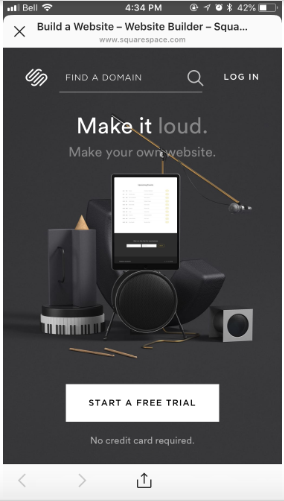
If you need or want to add more content to your landing page, like testimonials or feature details, keep the most important text above the fold.
Having some white space (or, in this Squarespace example, black space) looks good and directs the customer’s eye. Using arrows, bullet points, or other visual cues can help too.
Asking your visitor to fill out a subscription form, or share their contact information before downloading your ebook or app? Stick to the essentials and avoid adding too many fields for a higher conversion rate. Visitors coming from Instagram will be on mobile, which isn’t ideal for filling out long forms.
3. Show social proof
There’s a reason you check Yelp before picking a restaurant (or the analog method: choosing a place with lots of happy-looking eaters inside). Likewise, there’s a reason you don’t buy products that have one-star ratings and bad reviews on Amazon. Social proof is important to decision making because, generally speaking, if a lot of people like something, then it’s probably good.
Social proof can come in many forms:
- A glowing testimonial from an influencer
- Logos from companies that are using your service
- Ratings from users
- Number of users, downloads, or subscribers
- And more!
When it comes to testimonials, share authentic, specific details from real people about why your product or service is special. This adds credibility, and assures potential customers of your product’s value. Here are some elements of effective testimonials.
Remember: because you have limited space on your landing page, choose the best examples that reinforce your offer.
4. Make the value clear
Don’t get so caught up in persuading your audience what to do that you forget to persuade them why to do it. Communicate the value of your offer.
Often, an Instagram ad only provides enough characters to hint at the offer. On your landing page, you have the opportunity to flesh it out. Why should your customer take action now? Why should they choose you over a competitor? What makes this opportunity special?
Tangerine Bank’s landing makes it easy to spot the value.
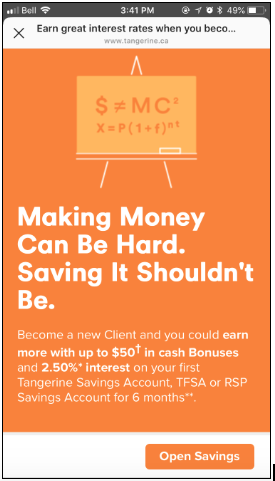
When explaining the value of your offer, provide specific examples. Don’t say that your product or service is “the best” or “better than the competition.” Vague and overblown statements are forgettable.
If you force customers to search for the details they want, you risk losing their interest (remember: we have short attention spans!). Instead, share what sets you apart from your competitors in concrete terms.
5. Message matching is key
Message matching is exactly what it sounds like: making sure your messages (in this case, on your Instagram ad and your landing page) are perfectly aligned.
This sounds intuitive, but often clicking on an ad takes you to a landing page on a totally different topic. Or the messaging is slightly different, contradicting the reason you clicked on the ad in the first place. If you saw a sign saying “FREE ICE CREAM!” outside an ice cream shop, and then inside you discovered that the ice cream was only free with a $20 purchase, you’d be rightly annoyed.
This kind of bait-and-switch is confusing and frustrating to customers. If you advertise a free app, but take someone to a landing page about a paid version, they’re not going to stick around.
Reiterating the exact wording of your ad copy in your landing page is often a good idea, because it proves that the customer is in the right place.
HelloFresh, a meal-planning service, does this well on their landing page. The Instagram ad promises a special offer of three free plates. This same offer is echoed at the top of the landing page, delivering on that promise.
As in this example, message matching not only prevents confusion, but it also builds trust.
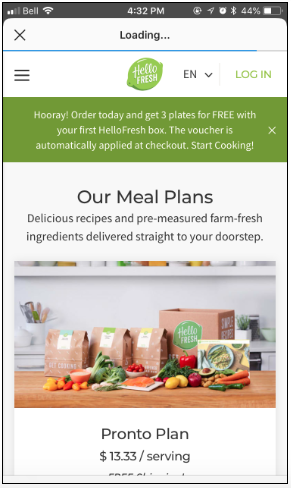
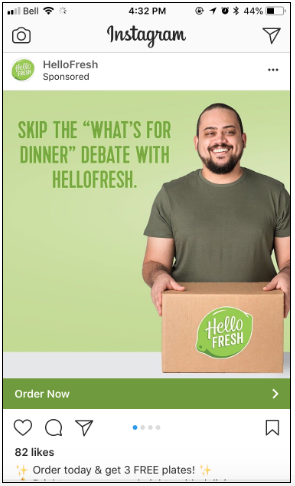
6. Create a seamless visual experience
Maybe you’ve heard that 60 percent of top brands on Instagram use the same filter for every single post. That’s because visual consistency is important for your brand identity, and for creating a pleasing browsing experience.
The look and feel of your landing page should align with your Instagram ad and your website. Use images and fonts that are similar to the ones in your ads. This kind of continuity increases the likelihood of a purchase.
If you’ve ever been in a lovely boutique that had terrible changing rooms, you know how much a that jarring transition can affect your experience. Don’t let your landing page be the unflattering changing room of your brand!
Wealthsimple, an investing management service, transitions smoothly to their landing page. Notice how it reflects the colours, graphic shapes, and fonts of its Instagram ads?
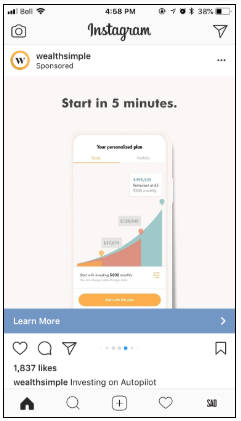

7. Use different landing pages for different ads
Now that you know how important message matching and consistent visuals are for successful landing pages, you can understand why you should be updating your landing page for each ad.
That doesn’t mean you need to reinvent the wheel each time. You can simply update the text of the landing page to mirror the headline on your Instagram ad, or replace the image to match the ad.
For instance, Skillshare created Instagram ads showcasing each of their different courses. An ad featuring logotype designer Jessica Hische that invites customers to sign up for Skillshare leads to a landing page that features Jessica’s course.
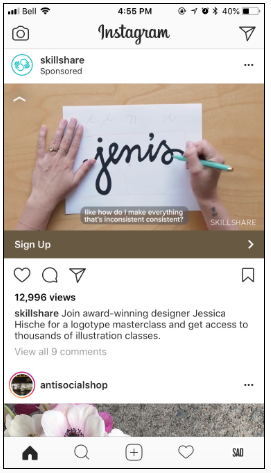
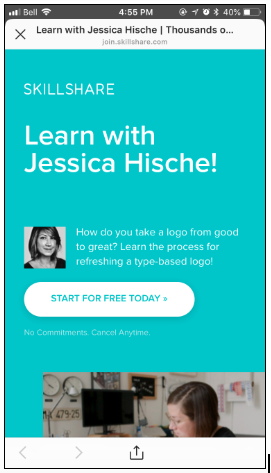
8. Experiment for improvement
Just like you should always test your Instagram ads, you should also test how different elements perform on your landing pages. A/B test two versions of a landing page with the same ad, or tweak your landing pages regularly and see what performs best.
Try different CTAs to see what leads to more conversions. Experiment with including different images, or rearranging the elements on your landing page. See which influencer testimonial has the greatest impact. Get creative – you might be surprised by what works best!
As with any other experiment, these kind of tests will help you refine your strategy and get to know your customers. You’ll gain a better understanding of who your audience is, and what they’re looking for from you.
Instagram landing page tools
Making a landing page is easier than you think, thanks to companies that offer specialized tools to get the job done.
Unbounce offers everything you need to build and test landing pages to maximize conversions. With a large selection of customizable templates, you can create a landing page that fits any campaign or promotion. Of note is their Layout Assistant feature that makes it easy to see how your landing page will appear to an Instagram user browsing on mobile.
Lander is another company that allows you to design beautiful landing pages, no coding required. Over 100 landing page templates can be customized to help you turn ad clicks into conversions. It’s also easy to duplicate and edit the landing pages you create, so you can tweak them to align with different versions of your ads (as mentioned in point number 5).
Instapage claims to be able to take your conversion rate from 3 percent (on average) to 22 percent. Their secret sauce for optimizing the post-click experience is a range of customizable options, including options to match messages based on user demographics and search keywords.
With these tools, you can start building out landing pages that translate ad clicks into tangible impacts, taking your Instagram strategy to the next level.
Save time managing your Instagram presence using Hootsuite. From a single dashboard you can schedule and publish photos directly to Instagram, engage the audience, measure performance, and run all your other social media profiles. Try it free today.
The post So Your Instagram Ad Got a Click-Through: Now What? appeared first on Hootsuite Social Media Management.
Contributer : Hootsuite Social Media Management https://ift.tt/2lvwS4V
 Reviewed by mimisabreena
on
Tuesday, June 26, 2018
Rating:
Reviewed by mimisabreena
on
Tuesday, June 26, 2018
Rating:

















No comments:
Post a Comment